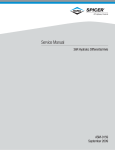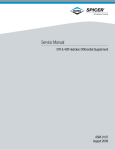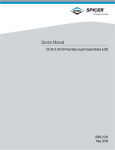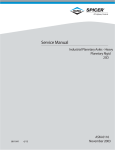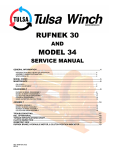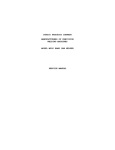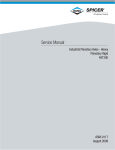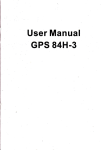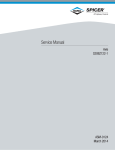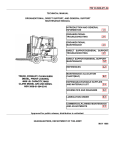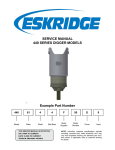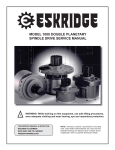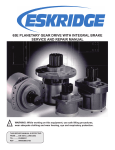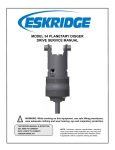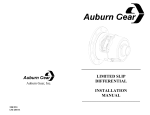Download Service Manual
Transcript
Service Manual Axle 42R Hydralock Differential ASM-0182 February 2003 FOREWORD This manual has been prepared to provide the customer and the maintenance personnel with information and instructions on the maintenance and repair of the Spicer Off Highway Products. Extreme care has been exercised in the design and selection of materials and manufacturing of these units. The slight outlay in personal attention and cost required to provide regular and proper lubrication and inspection at stated intervals, and such adjustments as may be indicated will be reimbursed many times in low cost operation and trouble free service. In order to become familiar with the various parts of the product, it’s principle of operation, troubleshooting, and adjustments. It is urged that the mechanics study the instructions in this manual carefully and use it as a reference when performing maintenance and repair operations. Whenever repair or replacement of component parts is required, only Spicer Off Highway Products approved parts as listed in the applicable parts manual should be used. Use of “will fit” or nonapproved parts may endanger proper operation and performance of the equipment. Spicer Off Highway products does not warrant repair or replacement parts, nor failures resulting from the use of parts which are not supplied or approved by Spicer Off Highway Products. Important: Always furnish the distributor with the serial and model number when ordering parts. CAUTION To reduce the chance of personal injury and/or property damage, the following instructions must be observed. Proper service and repair are important to the safety of the service technician and the safe, reliable operation of the machine. If replacement parts are required the part must be replaced with one of the same part number or with an equivalent part. Do not use a replacement part of lesser quality. The service procedures recommended in this manual are effective methods of performing service and repair. Some of these procedures require the use of tools specifically designed for the purpose. Accordingly, anyone who intends to use a replacement parts service procedure or tool, which is not recommended by SOHPD, must first determine that neither his safety nor the safe operation of the machine will be jeopardized by the replacement part, service procedure or tool selected. It is important to note that this manual contains various ‘Cautions’ and ‘Notices’ that must be carefully observed in order to reduce the risk of personal injury during service or repair, or the possibility that improper service or repair may damage the unit or render it unsafe. It is also important that these ‘Cautions’ and ‘Notices’ are not exhaustive, because it is impossible to warn of all the possible hazardous consequences that might result from failure to following these instructions. 1 Table of Contents 2 CLEANING and INSPECTION Cleaning Inspection Caution Bearings Clean all parts thoroughly using solvent type cleaning fluid. It is recommended that parts be immersed in cleaning fluid and agitated slowly until parts are thoroughly cleaned of all old lubricants and foreign materials. The importance of careful and thorough inspection of all parts cannot be overstressed. Replacement of all parts showing indication of wear or stress will eliminate costly and avoidable failures at a later date. Care should be exercised to avoid skin rashes, fire hazards and inhalation of vapors when using solvent type cleaners. Carefully inspect all rollers, cages, and cups for wear, chipping or nicks to determine fitness of bearings for further use. Do not replace a bearing without replacing the mating cup or cone at the same time. After inspection, dip bearings in clean light oil and wrap in clean lintless cloth or paper to protect them until installed. Bearings Remove bearings from cleaning fluid and strike larger side of cone flat against a block of wood to dislodge solidified particles of lubricant. Immerse again in cleaning fluid to flush out particles. Repeat above operation until bearings are thoroughly clean. When drying bearings, use moisture-free compressed air, being careful to direct air stream across bearings as to avoid spinning. Bearings may be rotated slowly by hand to facilitate the drying process. Oil Seals, Gaskets and Retaining Rings Replacement of spring loaded oil seals, gaskets, and snap rings is more economical when unit is disassembled than to risk premature overhaul to replace these parts at a future time. Loss of lubricant through a worn seal may result in failure of other more expensive parts of the assembly. Sealing member should be handled carefully, particularly when being installed. Cutting, scratching, or curling under lip of seal seriously impairs its efficiency. At reassembly, lubricate lips of oil seals with Multipurpose Lithium grease. “Grade 2” (MS107C). Housing Clean interior and exterior of housings, bearing caps, etc., thoroughly. Cast parts may be cleaned in hot solution tanks with mild alkali solutions, providing these parts do not have ground or polished surfaces. Parts should remain in solution long enough to be thoroughly cleaned and heated. This will aid the evaporation of the cleaning solution and rinse water. Parts cleaned in solution tanks must be thoroughly rinsed with clean water to remove all traces of alkali. Cast parts may also be cleaned with steam cleaner. Gears and Shafts Caution Care should be exercised to avoid skin rashes and inhalation of vapors when using alkali cleaners. Thoroughly dry all parts cleaned immediately by using moisture-free compressed air or soft lintless absorbent wiping rags free of abrasive materials such as metal filings, contaminated oil or laping compound. 3 If magna-flux process is available, use process to check parts. Examine teeth and ground and polished surfaces of all gears and shafts carefully for wear, pitting, chipping, nicks, cracks, or scoring. If gear teeth are cracked or show spots where case hardening is worn through, replace with new gear. Small nicks may be removed with suitable hone. Inspect shafts to make certain they are not sprung, bent, or splines twisted, and that shafts are true. Differential pinions and side gears must be replaced as sets. Differential ring gear and spiral pinion must also be replaced as a set if either is damaged. CLEANING and INSPECTION (Cont.) Housing and Covers At Reassembly Apply Thread Locking Compound Where Noted Inspect housing, covers, planet spider, and differential case to be certain they are thoroughly cleaned and that mating surfaces, bearing bores, etc., are free from nicks or burrs. Check all parts carefully for evidence of cracks or condition which cause subsequent oil leaks or failures. Guidelines for application where to apply: A. On bolts, capscrews, and studs (anchor end). B. On nuts, apply compound to the male thread of the mating fastener. C. Apply compound to coat the full length and circumference of thread engagement. D. Remove excess compound from mating parts after fastener installation. Reassembly of Axle The reassembly instructions describe the procedure to be followed when reassembling and installing components of axle. Instructions covering reassembly of opposite side is identical unless otherwise noted. Important: Class 8.8 and 10.9 and 12.9 fastening hardware has been used in the production of he axle assemblies covered in the manual. A table of proper torque values for the fastener classes above are provided within this manual. The class of hardware may be determined by the markings contained of the head of each capscrew. Class 12.9 torque values needs to be used on all sockethead capscrew used with this assembly. Torque values specified in text of this manual are for class 8.8, 10.9 hardware where presently used in production. On all axles being overhauled, bolts should be identified as described above and torque value chart consulted for correct torque. 4 RECOMMENDED LUBRICANTS FOR SPICER DRIVE AXLES Recommendations: Extreme pressure gear lubricant is recommended for use in all drive-steer and rigid drive axles except where explicitly stated differently by Spicer Off-Highway Products Engineering. Mineral Based: Acceptable lubricants must meet API GL-5/MT or MIL-PRF2105E qualifications. The highest viscosity grade must be used given the prevailing ambient temperatures from the chart below. Synthetics: Synthetic lubricants are recommended providing they meet API GL-5/MT-1 qualifications. The highest viscosity grade must be used given the prevailing ambient temperatures from the chart below. In general synthetic oils have a lower pressure viscosity response than mineral oil lubricants as the contact pressure between the gears increases. This produces a thickening of the mineral oil at the contact point. This increase in viscosity helps to maintain lubricant film thickness reducing the possibility of surface and spalling fatigue. Synthetic lubricants do not thicken as much under pressure unless specifically formulated to do so. Before using a synthetic lubricant in heavy applications, the customer must check with the lubricant supplier on the issue of high-pressure lubricant applications. Normal Oil Change Intervals: Oil change intervals for mineral based lubricants in normal environmental and duty cycle conditions is 1000 hours in all off-highway applications and 10,000 miles in on-highway applications. Severe or sustained high operating temperature or very dusty atmospheric conditions will result in accelerated deterioration or contamination. Judgement must be used to determine the required change intervals for extreme conditions. Extended Oil Change Interval: Extended oil service may result when using synthetic lubricants. Appropriate change intervals must be determined for each application by measuring oxidation and wear metals over time to determine a baseline. Wear metal analysis can provide useful information, but an axle should not be removed from service based solely on this analysis. Vehicles, which are prone to high levels of ingested water in the axle, or water as a result of condensation, should not use extended drain intervals. Friction Modifiers: Friction modifiers may be used with the lubricant to reduce Posi-Torq (limited slip) differential noise or liquid cooled brake noise. If friction modifiers are used, follow instructions on TSB 278E. The use of aftermarket lubricant additives other than those specified is not recommended and may reduce the life of the axle and void the warranty! Viscosity Based on Prevailing Ambient Temperature SAE 140 80W140 / 85W140 SAE90 80W90 75W90 75W DEG.C. F. -40 -40 -30 -22 -20 -4 -10 14 0 32 10 50 5 20 68 30 86 40 104 50 122 LEFT HAND SPIRAL SPIRAL BEVEL AND HYPOID TOOTH BEARING CONTACT CHART CONVEX SIDE – USE THIS PAGE All contact bearings shown below are on Left Hand spiral ring gear – the drive is on the convex side of the tooth. Fig. 1 Typical preferred bearing on both sides of tooth while under a light load. Fig. 2 Toe bearing on both sides of tooth – gear set noisy. To move bearing toward heel increase backlash within limits by moving gear away from pinion. Fig. 3 Heel bearing on both sides of tooth – gear set noisy and could result in early gear failure. To move bearing toward toe decrease backlash within limits by moving gear toward pinion. Fig. 4 Low bearing on gear and high bearing on pinion. Correct by pulling pinion away from gear (increase mounting distance). Fig. 5 High bearing on gear and low bearing on pinion. Correct by moving pinion toward gear (decrease mounting distance). Backlash Backlash should be measured with a dial indicator rigidly mounted with the stem perpendicular to the tooth surface at the extreme heel. 6 RIGHT HAND SPIRAL SPIRAL BEVEL AND HYPOID TOOTH BEARING CONTACT CHART CONVEX SIDE – USE THIS PAGE All contact bearings shown below are on Right Hand spiral ring gear – the drive is on the convex side of the tooth. Fig. 1 Typical preferred bearing on both sides of tooth while under a light load. Fig. 2 Toe bearing on both sides of tooth – gear set noisy. To move bearing toward heel increase backlash within limits by moving gear away from pinion. Fig. 3 Heel bearing on both sides of tooth – gear set noisy and could result in early gear failure. To move bearing toward toe decrease backlash within limits by moving gear toward pinion. Fig. 4 Low bearing on gear and high bearing on pinion. Correct by pulling pinion away from gear (increase mounting distance). Fig. 5 High bearing on gear and low bearing on pinion. Correct by moving pinion toward gear (decrease mounting distance). Backlash Backlash should be measured with a dial indicator rigidly mounted with the stem perpendicular to the tooth surface at the extreme heel. 7 FASTENER TORQUE 8 FASTENER TORQUE Coarse Threaded Fasteners Coarse Threaded Fasteners Coarse Threaded Fasteners 9 PINION STAKING Staking of the pinion end to the inner pinion is required when the inner pinion bearing or the pinion shaft and ring gear are being replaced. If a staking groove is in the pinion shaft, use procedure shown in Figure “A” and a square end staking tool. If pinion has no staking groove use procedure in Figure “B” and a standard prick punch to up-set the metal over the bearing inner race. 1/8” FIGURE A OPTIONAL CONSTRUCTION (NO STAKING GROOVE) FIGURE B 10 STAKE IN 6 PLACES EXPLODED VIEW 11 DIFFERENTIAL ASSEMBLY DESCRIPTION ITEM No. 1 2 3 4 5 6 7 8 9 10 11 12 13 14 15 16 17 18 19 20 21 22 23 24 25 26 27 28 29 30 31 32 33 34 35 36 37 38 39 40 41 42 43 44 45 DESCRIPTION Not Used In This Model Adjusting Nut Lockwasher Adjusting Nut Capscrew Differential Adjusting Nut Differential Bearing Cup Differential Bearing Cone Differential Case Seal Carrier Cap Washer Carrier Cap Capscrew Case Capscrew Case Washer Plain Half Case Side Thrust Washer Side Gear Pinion Gear Thrust Washer Pinion Gear Needle Roller Thrust Washer Pinion Needle Rollers Needle Roller Thrust Washer Differential Cross Clutch Side Gear Side Thrust Washer Ring Gear Capscrew Ring Gear Clutch Housing Clutch Driver Snap Ring Driver Friction Plate Reaction Plate Clutch Plate Piston Outer Seal Piston Inner Seal Piston Wave Seal Flange Half Case Case Washer Case Capscrew Case Plug Piston Rings Rotary Seal Gear Nut Inner Pinion Bearing Pinion Gear Differential Carrier and Cap Assy Differential Adjusting Nut Not Used In This Model Adjusting Nut Washer ITEM No. 46 47 48 49 50 51 52 53 54 55 56 57 57A 58 58A 59 60 61 62 63 64 64A 65 66 67 68 69 70 71 72 73 74 75 76 77 78 79 80 81 81A 81B 82 83 84 85 QTY 1 1 1 2 2 1 4 4 12 12 1 1 1 4 4 8 328 4 1 1 1 12 1 1 1 1 6 7 1 1 1 1 1 3 3 1 2 12 1 1 1 2 1 12 DESCRIPTION Adjusting Nut Capscrew Lip Seal Inner Seal Retainer Plug Cap Screws - Seal Retainer Lip Seal Outer Nipple O Ring Nipple Back Up Ring Tank Port Square Cut Seal Tank Port Back Up Ring Pressure Port Cap Cap Pressure Nipple Nipple O-Ring Seal Square Cut Pressure Port Plug Inner Pinion Bearing Cone Inner Pinion Bearing Cup Pinion Bearing Spacer Kit Bearing Cage Shim - .007 Bearing Cage Shim - .010 Pinion Bearing Cage Assy Outer Pinion Bearing Cup Outer Pinion Bearing Cone Pinion Seal Not Used In This Model Pinion Seal Retainer Grease Fitting Seal Retainer Lockwasher Seal Retainer Capscrew Seal Retainer Lockwasher Seal Retainer Capscrew Grease Seal Thrust Washer Not Used In This Model V-Ring Seal Not Used In This Model Flange O Ring Spacer O Ring Flange Nut Differential Case Assy Differential Body Assy Drive Gear and Pinion Set QTY 1 1 1 2 3 1 1 1 1 1 1 1 1 1 1 1 2 1 1 1 AR AR 1 1 1 1 1 2 7 7 1 1 1 1 1 1 1 1 1 1 1 1 Pinion Bearing Rolling Torque Instructions Install bearing cage and pinion shaft assembly in differential carrier without bearing cage shims. Use (4) oil pinion seal retainer bolts with flat washers to pull pinion shaft assembly fully into carrier assembly. Make sure oil passages are aligned. Install (3) flat washers on each bolt to prevent them from bottoming. Temporarily install companion flange on end of pinion shaft without installing pinion oil seal retainer. Install companion flange retaining tool on companion flange and torque flange nut to 600 LBF-LB (850 Nm). Remove companion flange retaining tool and use “inch-pound” torque wrench to check bearing preload. If bearing preload is not between 13 and 23 LBF-IN (1-3 Nm) the flange will have to be removed and the cage disassembled. Shims can then be added or removed as needed to obtain proper reading. Add shims to increase preload, remove shims to reduce preload. Reassemble unit and check again. 13 Pinion Mounting Distance Instructions A pinion setting gauge must be used to achieve a precise mounting distance between the ring and pinion. The use of the gauge will determine the amount of shims needed to achieve the proper mounting distance. The shims will be placed under the pinion bearing cage to achieve an exact mounting distance between the ring gear and pinion. By using the gauge and adding the proper thickness of shims, an optimum tooth contact will be obtained. Setting the ring and pinion mounting distance without the gauge will require a trial and error procedure. A shim must be installed under the pinion bearing cage and then the unit must be completely assembled per service manual instructions. The procedure must be repeated until proper tooth contact is obtained. T The position of the pinion as described will produce a proper tooth contact with the ring gear when it and the differential assembly are assembled and adjusted to proper backlash setting. The function of the gauge is to measure the distance from the centerline of the differential bearing bores to the ground surface on the end of the pinion gear. This measurement, when subtracted from the value etched on the ring gear will indicate the size of the shim pack required to position the pinion gear in proper relation to the ring gear. On the outer diameter of the ring gear, a ring gear to pinion mounting distance value will be etched. Add half the thickness of the gauge bar. Record this value. This value may be different on each ring and pinion set due to manufacturing variations. Insert a 4” base 5/32” diameter extension depth micrometer and 5”- 6” extension into the guide bore of the micrometer arbor. 1 2 Paint bearing surfaces of carrier housing with gear tooth marking compound. Mount adapter discs on micrometer arbor and set in position in carrier housing. Do not contact any part of the carrier in this operation. Apply pressure by hand and rotate adapter discs slightly to obtain a contact with bearing surfaces. 3 Remove checking gauge assembly and check for full bearing contact on bearing surfaces. 14 Pinion Mounting Distance Instructions (Cont.) 4 If contact is full and proper, position checking gauge assembly in carrier and check distance to ground surface on pinion (Figure 4). DO NOT APPLY PRESSURE to arbor or micrometer. Turn micrometer carefully and evenly until tip of extension contacts the ground surface of the pinion. In the assembly shown the distance measures 5.159 inches, the reading on the micrometer being .159 inch. Subtract this reading from the value etched on the ring gear, this equals the amount of shims to be added between the pinion bearing cage and the carrier housing. Example: 5.159 - Value etched on ring gear and half the thickness of the gauge bar. 5.129 – Initial micrometer reading. .030 – Add this value in shims. Remove bolts holding pinion bearing cage in differential carrier and remove bearing cage and pinion assembly. Install required shim pack and reinstall cage and pinion assembly in carrier. Tighten cage screws 177-199 LBF-FT (240-270 Nm) temporarily. After adding required amount of shims, again mount checking gauge assembly and recheck reading. The reading should now be .159 (5.159 inches) plus or minus .002 inch. In other words, the reading should be equal to value etched on the ring gear within .004 inch. 15 Differential Assembly Instruction 1. Apply Loctite 262 2. Apply Loctite 515 3. Select spacer to obtain a pinion bearing rolling torque of 13-23 LBF/IN (1.5-2.6 Nm ) with pinion assembled in carrier. This check to be made before differential is assembled and not to include pinion oil seal drag. 4. Differential assembly to be adjusted to obtain a backlash of .010 (.254 mm) to .014 (.355 mm) between ring gear and pinion. 5. Shim as required 6. Apply MS266 oil to both sides of clutch plates. First install one friction plate and then one reaction plate, repeat until all plates are installed. Align all grooves in plates with grooves in diff clutch housing. 16 Differential Assembly Instruction (Cont.) Instruction Drawing For Hydralock Differential Assemblies. Pressure Test Procedure. Air pressure test the pressure and tank port seals and system (Port W & V). Apply 12 psi (83 kPa) to pressure and tank ports simultaneously. Allow stabilization period of 20 seconds min. Lock off pressure and measure decay in 10 seconds. Alternate decay / period is .1 psi (.69 kPa) per 5 minutes. Hydraulic pressure test the pressure port seals and system (port W). Apply 600 psi (4137 kPa) to pressure port. Place open tank line back to tank. Allow stabilization period of 20 seconds min and release. Reapply 600 psi (4137 kpa) and monitor fluid for a one minute period. Fluid flow rate is not to Exceed .75 gpm (2.83 l pm). 17 Backlash and Ring Gear Runout Instructions Tighten bearing adjusting nuts to achieve “Zero Backlash”. Loosen the adjusting nut opposite the ring gear until it no longer contacts the differential assembly. Tighten the nut on the ring gear side until the ring gear contacts the pinion and zero backlash is obtained. Tighten the other adjusting nut until snug. Mount a dial indicator as shown in the photo, plunger contacting the gear tooth. Set backlash by loosening adjuster on ring gear side then alternately tightening the other adjuster. Gently rock ring gear back and forth while observing the dial indicator reading. Compare the dial indicator reading against the specs found in the Assembly Instructions section, page (16). Continue procedure until proper spec is obtained. Once proper backlash has been obtained tighten adjusting nut opposite ring gear to set bearing preload. Using only thumb and forefinger, move ring gear back and forth. When ring gear becomes difficult to move bearing preload has been set. Use dial indicator to check back face of ring gear. Rotate at least one full turn. Runout must not exceed .005 [0,12mm] total indicator reading. If runout is excessive remove assembly and check for burrs or dirt under mounting surface of ring gear. Reassemble and recheck. 18 Disassembly 1 Ring Gear Bolt Removal 2 Loosen (4) ring gear nuts. Remove the (4) nuts. 3 4 Carefully remove the (4) bolts with a brass driver. 5 Rotate the ring gear until the empty holes align with the pinion. Fitting Removal 6 Remove fitting caps. Loosen fittings. 19 7 8 Remove fittings. Cap Removal Loosen lock bolt. 9 10 Remove lock bolt. Loosen (4) cap bolts. 11 12 Remove (4) cap bolts. Loosen (3) retainer screws. 20 13 14 Remove screws. 15 Use rubber hammer to loosen caps. “WARNING” 16 Once the caps are removed the ring gear and differential assembly can roll out of the carrier housing. 17 Remove caps. Seal Retainer Removal 18 Remove seal retainer. Adjuster Removal Loosen adjusters and remove. 21 19 Differential Assembly Removal 20 Remove differential assembly from housing. 21 Note: Empty holes must be aligned with pinion centerline before removal. Case Half Disassembly 22 Carefully remove piston rings. Note: Edges of rings can cut fingers. Remove bearing cup. 23 24 Remove bearing cup opposite side. Remove differential case seal. 22 25 Ring Gear Removal 26 Remove all ring gear bolts with brass driver. Loosen and remove all ring gear nuts. 27 28 Use rubber hammer to remove ring gear. Place wooden blocks under ring gear. 29 Flanged Case Half Removal 30 Remove flanged case half bolts. Use rubber hammer to remove flanged case half. 23 31 Friction and Reaction Plate Removal 32 Remove reaction plates. Note: Friction and reaction plates may fall out when flanged case half is removed. 33 34 Remove friction discs. Clutch Driver Removal Remove snap ring. 36 35 Remove clutch driver. Case Half Removal Remove bolts. 24 37 38 Side Gears and Spider Disassembly Remove side thrust washer. Be sure to mark case halves before separating case halves. 39 40 Inspect cross and gears for wear. Replace as needed. Remove the cross and pinion assembly. Mark the cross and diff body section for easy alignment during reassemble. Remove differential side gear. 41 42 Remove thrust washers. Number each washer as removed. Remove differential pinion gears one at a time and place with proper thrust washer. 25 43 44 Remove clutch side gear. 45 Remove side thrust washer. Clutch Piston Disassembly 46 Install seal retainer. Carefully apply air to hole in seal retainer to remove clutch piston. Passage must be free of dirt or damage. 47 48 Passage must be free of dirt or damage. Remove clutch piston. 26 49 50 Remove inner and outer piston seals. Remove piston wave spring. 51 Seal Retainer Disassembly 52 Remove inner and outer lip seals. Flange Disassembly Loosen flange nut. 53 54 Remove flange nut. Carefully remove flange with puller. 27 55 56 Remove spacer O ring. 57 Remove O ring. Pinion Cage Removal 58 Remove bolts from seal retainer. Remove pinion seal retainer. 59 60 Remove pinion cage assembly. Install flange and flange nut. 28 61 Seal Retainer Disassembly 62 Remove thrust washer. 63 Remove grease seal. Pinion Cage Disassembly 64 Remove pinion seal. Place pinion inside of press. Press pinion, inner and outer cones out of cage. 65 66 Remove inner and outer bearing cups. Pinion Disassembly Remove pinion bearing spacer. 29 67 68 Press inner bearing off of pinion. Check for wear on pinion and bearing. Replace as required. 30 Reassembly 1 Pinion Reassembly 2 Note: All parts must be lubricated prior to reassembly, do not assemble dry. Stake pinion and inner race four places equally around diameter. Press inner pinion bearing on pinion. 3 4 Pinion Cage Reassembly Install pinion bearing spacer and .010 (.0254mm) shim (reuse old shim if reusing gear set). Press inner pinion bearing cone onto pinion. 5 6 Press inner and outer bearing cups in cage. Place bearing cage on pinion, install outer pinion bearing cone. 31 7 8 Check/adjust pinion bearing rolling torque following the procedure listed in the Assembly Instructions section pages ( 3 and 13). Pinion mounting distance must be set following the procedure on pages (14 and 15). Press bearing into cage assembly. 9 Seal Retainer Installation 10 Use correct driver to install the grease seal and pinion seal (2) in the seal retainer. 11 Install thrust washer into pinion seal retainer. Pinion Cage Installation 12 Apply Loctite #515 to bearing cage shims and joining surfaces in a continuous bead. Cover entire surface. Install bearing cage shim. 32 13 14 Position pinion cage assembly in carrier housing. Remove flange nut and flange. 15 16 Apply Loctite #515 to pinion bearing cage in a continuous bead across entire surface. Install pinion seal retainer. 17 18 Install seal retainer capscrews. Apply Loctite #262 to seal retainer capscrews. 33 19 20 Torque (7) capscrews to 177-199 LBF-FT (240-270 Nm). 21 Torque (1) capscrew to 74-81 LBF-FT (100-110 Nm). Flange Reassembly 22 Install “O” ring. Install spacer “O” ring. 23 24 Grease seal seat journal of drive flange with MS-107C. Install V-Ring seal onto flange. 34 25 26 Apply Loctite #515 to pinion threads. Install flange nut. 27 28 Side Gear and Spider Reassembly Install side thrust washer. Run nut down, then torque flange nut to 600 LBF-LB (815 Nm). 29 30 Lubricate clutch side gear and install. Grease differential cross. 35 31 Note: If new parts are not being used the cross must be assembled using the numbering system as directed in disassembly process. 32 Using a rubber band to facilitate assembly, install one row of needle roller bearings. Position inner needle roller bearing spacer on differential spider. 33 34 Using another rubber band install outer row of needle roller bearings. Install center roller bearing spacer. 36 35 Position pinion gear on needles as shown. Remove first rubber band. Slide pinion gear over second row of needles, remove second rubber band. Install outer roller bearing spacer and pinion thrust washer. 36 37 38 Install differential spider. Align case and spider marks. Install side gear. 39 40 Case Half Reassembly Align marks on plain half case with mark on flanged half case. Install plain half case. Install side thrust washer. 41 42 Apply Loctite #262 to case capscrews. Install case capscrews. 37 43 44 Torque to 74-81 LBF-FT (100-110 Nm). Clutch Driver Reassembly Install clutch driver. Note: The five holes in the clutch housing. 45 46 Friction and Reaction Plate Reassembly Install first friction plate. Note: Align plate holes with holes in clutch housing. Install snap ring. 47 48 Install first reaction plate. Note: Align reaction plate holes with holes in friction plate. Install all plates in order. Note: See assembly instructions page (16). 38 49 Clutch Piston Reassembly 50 Lubricate flange half case. Install piston wave spring. 51 52 Install inner piston seal. Install piston outer seal. 53 54 Use rubber hammer to install clutch piston. Lubricate seals. 39 55 Flanged Half Case Reassembly 56 Install bearing using press. Align marks and install flange half case onto clutch housing. 57 58 Apply Loctite #262 to capscrews. Install capscrews. 59 60 Install bearing and seal. Torque capscrews to 44-48 LBF-FT (60-65 Nm) 40 61 Ring Gear Reassembly 62 Use rubber hammer to seat ring gear flush. Align holes in ring gear and case. Install ring gear. 63 64 “Note: Leave four bolts out for pinion clearance.” Apply Loctite #262 to cap screws and install. Leave (4) capscrews out. Install nuts 65 66 Torque nuts 150-168 LBF-FT (203-228 Nm). Differential Assembly Install diff body assembly into carrier. “Note: Four holes rotated to the bottom.” 41 67 68 Install differential bearing cup. Install differential adjusting nut. 69 70 Install cap and capscrews. Tighten lightly do not torque. 71 72 Note: See Assembly Instructions for backlash setting procedure and ring gear runout checking procedure. See pages (16 and 18). Cap Installation Apply Loctite #262 to capscrews. 42 73 74 Install caps and capscrews. Torque to 300-360 LBF-FT (407-488 Nm). Recheck backlash, correct as needed. Apply Loctite #262 to adjusting lock capscrew and install. 75 76 Torque capscrew to 25-28 LBF-FT (34-38 Nm). Rotate empty ring gear holes to the top. 77 78 Install capscrews and nuts. Torque nuts 150-168 LBF-FT (203-228 Nm). 43 79 80 Install piston rings. Seal Retainer Installation Apply Loctite #262 to seal retainer. 81 82 Apply Loctite #620 to outer lip seal. Using proper driver, install outer lip seal. 83 84 Apply Loctite #620 to seal retainer. Lightly apply Loctite #620 to inner lip seal. 44 85 86 Use proper driver to install inner lip seal. Lubricate piston rings. 87 88 Install seal retainer guide. Install seal retainer. 89 90 Apply Loctite #262 to capscrews. Install capscrews. 45 91 92 Torque screws 10-20 LBF-IN (1-2 Nm). Fitting Installation Install O Ring on fitting. 93 94 Repeat procedure for other fitting. Install back up ring and then the square cut seal on fitting. 95 96 Tighten fittings to 15 LBF-FT (20 Nm) and install caps. Install fittings. 46 Copyright 2013 Dana Holding Corporation All content is subject to copyright by Dana and may not be reproduced in whole or in part by any means, electronic or otherwise, without prior written approval. THIS INFORMATION IS NOT INTENDED FOR SALE OR RESALE, AND THIS NOTICE MUST REMAIN ON ALL COPIES. For product inquiries or support, visit www.dana.com or call 419-887-6445 For other service publications, visit www.SpicerParts.com/literature.asp For online service parts ordering, visit www.SpicerParts.com/order.asp
















































